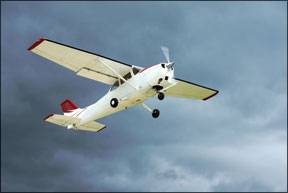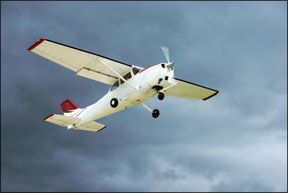Having the instrument rating opens up a wide range of options for planning and completing flights our VFR-only brethren cant make. But the instrument ticket usually is not a piece of paper allowing go-anywhere, anytime capability, especially when used with most personal aircraft. Often, however, the same flight can be completed safely by staying VFR. More planning may be required, and youll likely be busier than if you went IFR, but safety isnt likely to be compromised. Here are some reasons you might want to stay 288 VFR, and ways to do it safely. Headwinds Depending on what youre flying, its fuel capacity and the distance to your destination, staying low against stiff headwinds can turn a long flight with marginal fuel planning at your normal cruising altitude into a much shorter no-brainer. Often, however, getting low enough to minimize the headwinds means youll be below the minimum en route altitudes. And, of course, the terrain has to cooperate. Late one winter afternoon, I found myself somewhere in central Florida, planning to hop up to Georgia for the night and continuing to my home in Virginia the next day. Looking at the weather for that afternoon and for the next day didnt generate any huge problems, but I was going to be staring at some 30 knots on the nose either day at my normal cruising altitude for that route. But the forecast winds at 3000 feet for the entire Eastern Seaboard were either light and variable, or offered only a slight headwind. Having flown much of that route earlier in the day, I knew howling headwinds awaited anyone headed in that general direction who climbed much above 3000 feet. I realized that once everyone and everything was aboard and we were airborne, getting home required maybe an additional three hours. Doing it all at once eliminated the hassle of loading/unloading/reloading the airplane again before getting home, as well as the expense of another night on the road. It was a matter of fly me now, or fly me later. I posed my “lets get it over with” solution to my passengers and was greeted with, “Lets do it.” We launched, quickly leveled off at 2500 feet msl and motored from Florida all the way to Virginia at that altitude, VFR. Yes, we could also have flown that route IFR, but not at 2500 feet; the average MEA along the route is going to be in the 3500-to-4000 foot range, and there was a guaranteed re-route around some terminal airspace along the way. Climbing up into the stiff winds and accepting different routing would have added at least an hour to the return flight. Fuel wasnt an issue either way-presuming the weather held at my destination-but one of the reasons I fly personal airplanes is to get places quickly. Droning along with “only” 130 knots or so of groundspeed isnt my idea of a quick trip. Now, flying a long-distance trip at a relatively low altitude isnt everyones cup of tea. However, Id grown quite familiar with the area over the years and knew there was no terrain in the way. There are a few taller antenna farms, but they would be well away from the direct route. Basically, there was nothing to hit, no headwind to speak of, plus plenty of divert fields if the weather caved. I always could ask for a pop-up IFR clearance and climb into the headwind if I needed it, and-especially with the winds at altitude-I had the fuel to fly most of the way, if not all of it, to my destination then turn around, climb and let the wind push me most of the way back to my departure point. It truly was a no-brainer. But avoiding winds at altitude can mean a much higher cruising level than what some might consider scud-running. Depending on the airplane and its fuel burn as one example, staying VFR at either 16,500 or 17,500 feet will get you as high as you can go without doing it IFR. Such a choice can be a time and fuel-saver if the winds at, say, FL240 are much stiffer than below the Class A. Icing Another great reason to go VFR in a personal airplane instead of IFR is in-flight icing. Depending on the terrain, the airplane, the MEAs and other weather factors, it can be downright foolhardy to drive into IMC if icing is in the forecast. Remaining low enough and warm enough to eliminate any possibility of in-flight icing is the way to go. The typical scenario is this: Its winter, the air is holding some moisture, but the dewpoint is at or below freezing with surface temps around or above 40 degrees F. Presuming-again-terrain features or even special-use airspace doesnt pose insurmountable obstacles and employing the standard two-degree C lapse rate, there should be a cloud deck starting around 4-5000 feet msl. Whether an Airmet Zulu (the one for in-flight icing) has been issued or not, that altitude and cloud condition is where I start looking for ice to accumulate on the airframe. Since I dont have the bucks to fly a de-iced airplane, much less one approved for known icing, I try to not to tempt fate. Armed only with a warm pitot tube, you shouldnt either. Again, this is a situation where the need to comply with MEAs and other restrictions means its probably safer to go VFR. Also, the type of in-flight icing expected along the route or segments of it should enter into your evaluation. For example, if the forecast icing is for freezing rain, even if you stay in warmer air, you wont have an enjoyable flight. Again, of course, going VFR to stay below an area of in-flight icing doesnt mean you should cut corners. Look at the route for terrain, airspace and other impediments before you launch. Almost by definition, of course, the weather in such an instance is “iffy” and can change rapidly. Closely monitor it while en route, along with the ATIS/AWOS broadcasts from airports along the way to ensure you have a good, VFR divert available at all times. Unlike with the aforementioned headwind, there may be little future in climbing and requesting a pop-up IFR clearance. Thunderstorms As weve seen, avoiding unpleasant or risky weather is a good reason to go VFR instead of IFR. The same is true when thunderstorms are in the forecast, especially in the absence of frontal activity. The typical scenario involves so-called air mass storms popping up all along your route. Whether resulting from airspace, routing or other operational constraints, boring through the area IFR might mean an uncomfortable ride at best. At worst, a cloud deck or visibility restriction at altitude means a very real chance of an inadvertent thunderstorm penetration exists. This is a possibility even if youre using in-flight weather resources like XM Wx, an sferic device like a Strikefinder or even airborne weather radar. Stuff happens. While there always are exceptions, air mass thunderstorms dont really organize themselves into lines and clusters, or march off in a certain direction ahead of a cold front. Instead, since the kind of storms were thinking of dont involve frontal activity, they move with the prevailing winds. In any event, they usually provide quite a bit of distance between each other and, at least in our experience, have relatively high bases. To understand why, it helps to know why and how air mass thunderstorms develop. Air mass thunderstorms form away from frontal activity when the air holds sufficient moisture and surface terrain is heated by the sun. As surface air rises, so does the moisture. Eventually, that moisture condenses into clouds and liquid water, but may not stop rising. As it rises, a thunderstorm develops. These storms are prevalent in tropical and near-tropical climates like Florida and the southern U.S., much of the year but can occur anywhere sufficient moisture and daytime heating exist. While they generally are weaker, smaller and less destructive than their front-related kin, air mass thunderstorms certainly are not to be trifled with. The great thing is they usually are easy to circumnavigate, which is where staying in visual conditions comes in. After all, thunderstorms are easier and less risky to avoid when remaining in visual conditions. The flip side is-whether for traffic, airspace, routing or other reasons-ATC may not allow the kind of deviations you need to avoid air mass thunderstorms. In such a situation, being VFR to begin with eliminates many of these concerns. A final caveat: Messing around with thunderstorms associated with frontal activity or forming in lines and clusters when VFR probably isnt a good idea. Often, IFR isnt either. Leave the airplane in the hangar and pull it out when the storms have moved off. Airspace Another reason to go VFR instead of IFR can involve the airspace between you and your destination. Of course, going IFR pretty much always ensures you wont stumble into a pop-up TFR or suddenly-active Restricted Area. But the IFR system also exacts routing penalties around Class B airspace, as one example, and also precludes penetrating a Military Operations Area. The resulting change from the more-or-less direct routing when VFR to the circuitous, weve-got-to-put-them-together-to-keep-them-apart routings ATC often comes up with cries out for cancelling IFR and going visually. Or starting out VFR in the first place. Usually, choosing a different altitude can fix things, and ATC will offer to move your IFR flight up or down when approaching, say, an active MOA in the way. And, while we dont advocate penetrating such airspace, doing it VFR is legal; depending on the operational considerations you might be facing-fuel, or an altitude-sensitive passenger, for example-doing it VFR is a good option. Remember: ATC cannot cancel IFR for you; thats a decision only you can initiate when conditions permit. A looming Class B might also be a good reason to go VFR. Approach controllers often take a dim view-unreasonably in our opinion-of IFR traffic even close to the lateral boundaries of their precious Bravo. Terrain A final reason to go VFR can involve terrain. In the western U.S., especially, rather high MEAs exist along some routes, often maxing out personal airplane performance. With some of the flivvers we fly, there just isnt enough left over when flying at or near the airplanes service ceiling. Depending especially on the winds, but also on other weather it can be more comfortable flying lower than the MEAs allow. Turbocharging-or turbines-resolves a lot of these concerns, but not everyone can justify the added expense and maintenance for just one or two flights a year where it can make the difference. Meanwhile, staggering along at below-optimum airspeeds and angles of attack is not a pleasant way to fly. Presuming weather, wind and airspace make going VFR an option, doing so can eliminate the challenges an IFR routing might present while also giving you and your passengers a much better view of some spectacular sights. One thing weve learned-the hard way-over the years is the unpleasant turbulence generated by strong winds moving over uneven terrain doesnt respect the flight rules under which youre operating. If the wind is honking, it wont matter if youre IFR or VFR; youll get a rough ride. Depending on the mission and the airplane, it might be better to wait for calmer winds, a smoother ride and less airborne stress. Not for Everyone There are those-you know who you are-who file and fly IFR everywhere, every time. Nothing wrong with that, and weve embraced that philosophy ourselves. But there are times when IFR isnt convenient and, as weve tried to demonstrate, situations where going VFR resolves an operational constraint presented by the more-structured option. The keys are knowing you have the option, having a good understanding of the challenges involved and a reason other than “I dont want to go IFR today” before deciding VFR is the best choice.




